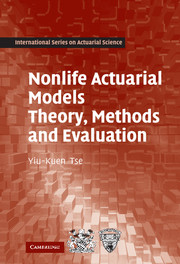Book contents
- Frontmatter
- Contents
- Preface
- Notation and convention
- Part I Loss models
- 1 Claim-frequency distribution
- 2 Claim-severity distribution
- 3 Aggregate-loss models
- Part II Risk and ruin
- Part III Credibility
- Part IV Model construction and evaluation
- Appendix: Review of statistics
- Answers to exercises
- References
- Index
3 - Aggregate-loss models
from Part I - Loss models
Published online by Cambridge University Press: 05 June 2012
- Frontmatter
- Contents
- Preface
- Notation and convention
- Part I Loss models
- 1 Claim-frequency distribution
- 2 Claim-severity distribution
- 3 Aggregate-loss models
- Part II Risk and ruin
- Part III Credibility
- Part IV Model construction and evaluation
- Appendix: Review of statistics
- Answers to exercises
- References
- Index
Summary
Having discussed models for claim frequency and claim severity separately, we now turn our attention to modeling the aggregate loss of a block of insurance policies. Much of the time we shall use the terms aggregate loss and aggregate claim interchangeably, although we recognize the difference between them as discussed in the last chapter. There are two major approaches in modeling aggregate loss: the individual risk model and the collective risk model. We shall begin with the individual risk model, in which we assume there are n independent loss prospects in the block. As a policy may or may not have a loss, the distribution of the loss variable in this model is of the mixed type. It consists of a probability mass at point zero and a continuous component of positive losses. Generally, exact distribution of the aggregate loss can only be obtained through the convolution method. The De Pril recursion, however, is a powerful technique to compute the exact distribution recursively when the block of policies follow a certain set-up.
On the other hand, the collective risk model treats the aggregate loss as having a compound distribution, with the primary distribution being the claim frequency and the secondary distribution being the claim severity. The Panjer recursion can be used to compute the distribution of the aggregate loss if the claim-frequency distribution belongs to the (a, b, 0) class and the claimseverity distribution is discretized or approximated by a discrete distribution.
- Type
- Chapter
- Information
- Nonlife Actuarial ModelsTheory, Methods and Evaluation, pp. 86 - 112Publisher: Cambridge University PressPrint publication year: 2009



